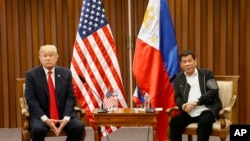The Philippines has reinstated its Visiting Forces Agreement (VFA) with the United States, said Foreign Affairs Secretary Teodoro Locsin, Jr. Tuesday on Twitter.
The island nation had announced the termination of the 1988 agreement in February, providing the mandatory 180 days’ notice. According to terms of the termination process, the nations had until August to restore the accord.
The decision to revive the deal was made “in light of political and other developments in the region,” Loscin said in a diplomatic letter sent to Washington. He did not elaborate.
The U.S. embraced the Philippines’ change in policy. “Our longstanding alliance has benefited both countries, and we look forward to continued close security and defense cooperation with the Philippines,” said the U.S. embassy in Manila in a statement.
Analysts say the reversal indicates the Philippines now thinks China has become an increased threat, inducing a desire for the security a U.S. military deterrence could offer.
The VFA, which permitted the U.S. military to conduct joint exercises in the Philippines, also gave the Philippines’ armed forces training to combat terrorism and drug trafficking. Additionally, the exercises were seen as a response to China’s recent encroachments of disputed territory in the South China Sea.
Philippine President Rodrigo Duterte’s February announcement on canceling the pact with the U.S. was viewed as a strategic realignment with historic enemy China, coming on the heels of his pronouncement that, "I need China. More than anybody else at this point, I need China.”
Duterte also characterized the U.S. as “ill-mannered” and said that the deal was unfair.
Duterte has often painted China’s military action in the South China Sea as benign and harmless, even as China’s People’s Liberation Army has moved increasingly advanced anti-submarine and reconnaissance craft into disputed waterways.
Several other places, including Vietnam and Taiwan, are also locked in territorial disputes with China in the South China Sea.
An average of 18 Chinese vessels have been around the Philippines each day, according to an analysis published in March by the Asia Maritime Transparency Initiative of the Center for Strategic and International Studies.
Bonnie Glaser, director of the China Power Project at the CSIS in Washington, tells The New York Times that the restoration of the VFA is a setback for China.
“Beijing has long sought to weaken U.S. alliances, and has benefited from the friction in recent years in U.S.-Philippine relations,” she told the paper. “So, a decision by Manila to suspend plans to terminate the VFA will be seen as contrary to Chinese interests.”
China has not made a public statement regarding Duterte’s reversal.
